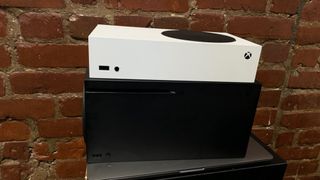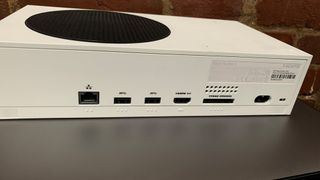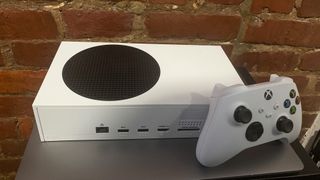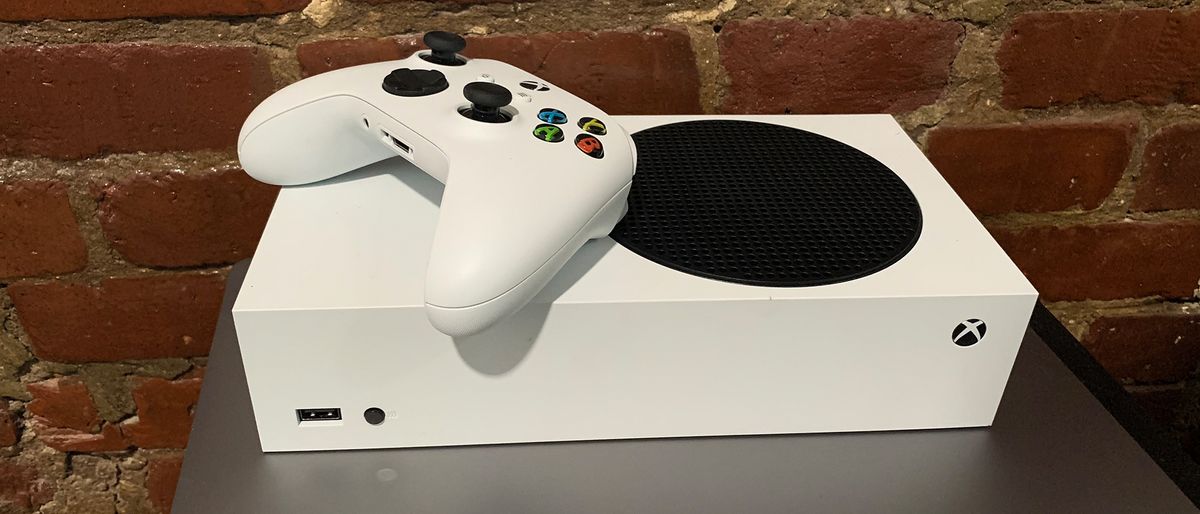Laptop Mag Verdict
The Xbox Series S offers 4K gaming and lightning-fast load times in a small, compact chassis, but you miss out on some features in the name of affordability.
Pros
- +
Super affordable
- +
Compact, stylish chassis
- +
Blistering-fast load speeds
- +
Great performance
Cons
- -
Lacks future 8K support
- -
Less power and storage than Xbox Series X
Why you can trust Laptop Mag
Yes, everyone’s excited about the Xbox Series X, but don’t forget Microsoft is releasing two next-gen consoles. The Xbox Series S has also hit stores and at a much more affordable $299. For the price, you get a console that can play games at 4K at 60 frames per second. Not enough frames for you? It can also kick things up a notch to 120 fps. It also has lightning-fast load speeds, and the ability to suspend up to six games until you’re ready to play again.
There are a few concessions to be made at that price. For instance, that 120 fps I just mentioned can only be achieved at 1440p resolution. Plus, the console lacks a physical disc drive and 8K support. But for gamers who are looking for next-gen goodness at an affordable price, the Xbox Series S is hands down a winner.
Xbox Series S pricing and configurations
The Xbox S is priced to move at $299. For the price, you get a much more petite piece of hardware compared to the $499 Xbox Series X. So much so that it lacks a physical disc drive. It’s also not packing the powerful specs of its bigger brother, but we’ll go more into that later.
Each system ships with an updated Xbox controller and a power cord. However, the Series S ships with a high speed HDMI cable whereas the Series X comes with an ultra high speed cord.
Xbox Series S design
This thing is straight-up adorable. I haven’t seen a console this cute since the Nintendo GameCube. I was compelled to make baby talk at the Series S when I first removed it from its box. It’s that freakin’ cute. At 4.3 pounds, 10.8 x 5.9 x 2.6 inches, the Series S is much smaller than the Series X (9.8 pounds, 12 x 6 x 6 inches). And next to the PlayStation 5 (9.9 pounds, 9.9-pound, 15.4 x 10.2 x 4.1 inches), the Series S looks positively Lilliputian.

I had no problem fitting it into my entertainment set with my ever-growing collection of consoles. Although I currently have the Series X and the PS5 standing vertically, the Series S’ natural orientation seems to be horizontal. How else are you going to admire the slightly raised, black matte circular vent at the top of the otherwise matte white plastic housing. The presentation makes me think of Domino, the mutant bounty hunter. Look closely and you’ll see the Xbox logo carved discreetly into the top-right corner.

Along the front of the device in the top-left corner is the power button hiding as the Xbox emblem. Like previous Xbox consoles, the logo glows white when the system’s powered on. In the bottom right corner sits a USB Type-A port and the pairing button for your wireless controller. The sides of the console are massive grills for the fans although there are four raised rubber feet in the corners of the right-side vent in case you want to stand the console up vertically. You’ll find the same feet along the bottom of the console for horizontal orientation.
The back of the console houses two USB Type-A ports, an HDMI, a Gigabit Ethernet port, the proprietary storage expansion slot, a secure lock slot and a power input.
Xbox Series S specs
The Series S is equipped with a 3.6-GHz AMD Zen 2-based processor with 10GB of RAM, a 4-teraflop AMD RDNA 2 GPU with 20 compute units and 512GB of storage. The Series X lives up to its title as the world’s most powerful console with its 8-core 3.8-GHz AMD Zen 2-based CPU, 16GB of GDDR6 RAM, 12-teraflop AMD RDNA 2 GPU with 52 Compute Units (CU) and a 1TB custom NVMe SSD. However, the PS5 isn’t too far behind with its 8-core, 3.5-GHz AMD Zen 2-based CPU, 16GB of GDDR6 RAM, 10.3-teraflop AMD RDNA 2 GPU with 36 CU and a custom 825GB SSD.
Xbox Series S 4K, 120 FPS and HDR
Both the Series S and the Series X can run games at 4K. And both systems can reach a frame rate of 120 fps. However, the way each system achieves its target is vastly different. In the case of the Series S, the console can run games at 4K at 60 frames per second. If you’re looking for that sweet, sweet 120 fps, the resolution drops to 1440p, which honestly ain’t too shabby. Its more powerful brother pulls out all the stops with the ability to run games at 4K, 120 fps. And in case you’re wondering why that 120 fps is so important, it makes for a smoother experience at 60 fps and better animation detail and less input lag.

There are currently 16 games that support 120 fps, including Ori and the Will of the Wisps, Gears 5 and Touryst, an upcoming title. The library is sure to grow after launch. For older games that haven’t been optimized for 4K and the joys of high frame rates, both the Series S and X can upscale content to at least 4K at 60 fps.
If you’re looking to enjoy non-gaming 4K content on the Series S, you’re going to have to turn to Netflix or Amazon Prime Video. Since the system lacks the 4K Blu-ray drive of its big brother, you’ll have to make due.
In addition to high frame rates and 4K resolution, each console offers High Dynamic Range (HDR). And if you want your games to look their best, I suggest you enable HDR as soon as humanly possible. With the setting enabled, you get more saturated hues and deeper contrasts. Which meant that the green goo dripping from D’Vorah’s hands in her Venomous style in Mortal Kombat X looked damn near fluorescent. And the colorful world of Ori and the Will of the Wisps looked even lovelier with pops of sapphire, ochre and amethyst sprinkled throughout the world
Other graphical improvements include DirectX Raytracing, a feature which has only just come to high-end PCs. It’s essentially a technology that renders more realistic lighting and, by extension, shadowing. The CPU and GPU work in tandem to process and render the scene, simulating and tracking every ray of light produced by a source of lighting. So if a ray of sunshine hits a shiny object, the system will calculate where the resulting reflecting beams will land and render it. It’s a technique that filmmakers have been using for CGI for a while now so you can imagine the implication for games.
Variable Rate Shading or VRS is another big feature. The technology gives developers more control over the rendering of individual pixels in a scene. So instead of taxing the GPU to reproduce every one of the millions of pixels in a scene, a developer can prioritize individual effects on specific objects or characters. In layman’s terms, that means if you're supposed to be focusing on your character gaining an important item, all those background elements don’t need to be as sharp. The GPU, directed by the developer, can focus on what’s important, leading to crisp details in the foreground with less definition in the background.
But how does it play? In the case of Ori, playing at 4K, 60 fps is an absolute treat. When I wasn’t held in thrall by the rich colors and fine details, like the prickly spines of a bright pink plant, the game definitely ran smoother at 60 fps.
Xbox Series S controller
The Series S and X come with the same redesigned controller. While the Series X’s controller has a matte black finish, the S is done in matte white. Like every Xbox controller before it, this new entry is powered by a pair of AA batteries. However, you can connect the Xbox to a computer or the console via a USB Type-C cable. And if you want to do your part for the environment, you can purchase the $24.99 rechargeable play-and-charge kit, which cuts down on battery waste and allows you to charge the controller via USB Type-C.

The Series S controller’s smooth casing gives way to tiny raised dots along the back of the arms, trigger buttons and the bottom portions of the shoulder buttons for a nice textured grip. The shoulder and trigger buttons have about the same level of actuation of the Xbox One controllers, but the buttons are more rounded.
Borrowing from the Elite controllers, the new controller sports a hybrid D-Pad that Microsoft says will deliver accurate inputs from both cardinal directions and diagonals. Microsoft also took inspiration from Sony and added a Share button to its traditional button spread, placing it below the View and Menu buttons.
Connectivity is big for Microsoft with the controller using Xbox Wireless Radio to allow the new controller to work with the Series X and S as well as the Xbox One and One S. But Microsoft didn’t stop there. The controller will also shake hands with PC, Android and iOS devices. It will also have the ability to remember multiple devices which is music to the ears for someone with several Xboxes, laptops and mobile gadgets.

To combat input lag, Microsoft has added what its calling Dynamic Latency Input (DLI) technology, which works with technology in the console and your TV’s HDMI connection. Button press information is transmitted more frequently and exactly matched with the frames of the game on screen. Microsoft says that this will shave milliseconds off the overall response times, which will make most gamers happy, particularly fans of FPS and fighting games.
At 9.8 ounces (9.3 ounces without batteries), 6.1 x 4.5 x 2.5-inch new controller is somewhat wider than the Xbox One controller (9.9 ounces 6.1 x 4 x 2.4).
Xbox Series S audio
In addition to its beautiful graphics, the Series S also has 3D audio to create a more immersive gaming experience. Similar to PlayStation 5, the Series S will rely on the GPU and Head-related Transfer Function, or HRTF, for its immersive soundscapes. HRTF deciphers how an individual's ear receives sound. It’s a cool trick, but since everyone’s ear is shaped differently, so is the way everyone interprets noise.
Microsoft’s audio technology also works with Dolby Atmos, Virtual Surround Sound for headphones, DTS:X and Windows Sonic. With all that software support, both the Series X and S can produce spatial audio.
Xbox Series S user interface
Xbox is giving gamers a more polished version of its previous tile interface with a focus on faster navigation. And if you already have an Xbox One X or S, you can transfer all your carefully tweaked settings to the new gen systems with a touch of a button during the initial setup.
The biggest changes will be found in the Guide layout, which is accessed by clicking on your profile icon in the top-left corner. Microsoft did a lot of pruning to the previous interface, making it easier to get to important utilities. At the top nav bar, you have icons for Home, People, Parties & Chats, Achievements, Capture & Share and Profile and System –– all of which can be rearranged to your preference in Settings.

Each tab has been streamlined for access to the most important features faster. Starting at Home, you’ll see My games & apps along with your four most recent apps. At the bottom, you have five icons representing Notifications, Xbox Game Pass, Store, Search and Audio. Party & Chats now houses message previews and you can adjust chat volume per person.
Meanwhile, you can find Friend Suggestions and Discover Clubs under the new Find Someone and Looking for Group options in people. The new Notifications inbox found under home combines all of your alerts, invites and messages into one feed. The Activity Feed has also undergone a makeover, with a greater focus on user-generated content, which should allow you to see your friend’s exploits more easily.

As for the main Home page, the first row is reserved for your most recent activities with the second for My games & apps and the third for Game Pass. From there, you have Store, Entertainment, Events, Community Pins and Microsoft Rewards. At the bottom is the “Add more” tab, which, as the name suggests, lets you add more rows to the mix including games and friends.
The Home screen can be customized from the order in which everything appears to the background themes and colors. For now, I have a dynamic theme that switches between light and dark depending on the time of day.
Xbox Series S Smart Delivery and Quick Resume
Console or PC? Xbox continues to blur the lines with its new Smart Delivery feature. Whether you purchase a game on the Series X, S or the One X, S, even the OG Xbox One, Smart Delivery ensures that the game will work across each system. Not only that, but the title will run within console-specific restraints to make sure you’re getting the best version of the game depending on the console.

That means if you’re playing on the Xbox One, the resolution and frame rate will be capped at 1080p, 30 fps while the One X would bump it up to 4K and 60 fps depending on the title. The same game on the Series X will play at 4K, 120 fps, provided the game is optimized for the higher frame rate.
But my favorite feature hands down is Quick Resume. This nifty new feature allows you to pause a game wherever you are –– in the middle of a cutscene or the thick of the action –– and suspend it in that state and hold it in storage without exiting the game. Meanwhile, you can launch another title. And when you’re ready to go back to the original title, you can instantaneously switch back with the game in the exact spot you left off.
Depending on how large or complex the game is, Quick Resume can support 4-6 games, keeping them suspended in the custom NVMe SSD. I managed to do this with Gears 5, Assassin’s Creed Odyssey, Mortal Kombat X, Ori and the Will of the Wisps and Witcher 3. While it’s a cool feature, I wish you could switch between tabs similar to how you can on a smartphone or tablet instead of having to go the Guide and cycle through everything going on in there.
Xbox Series S performance
It’s a given that the Series S isn’t as powerful as the Series X, but that doesn’t mean that it can’t provide a great gaming experience. On the contrary, the Series S can absolutely handle all those next-gen optimized games you’ve been hearing so much about. For my testing, I downloaded Gears 5, The Falconeer, Ori and the Will of the Wisp and Destiny 2.
I started with an oldie but goodie: Gears 5. It’s one of the titles that has been optimized to run at 4K and 60 frames per second or if you’re playing on my LG OLED55E8PUA TV, 120 fps. As I fought my way through a choke point filled with hostile Swarm, the bullets and gore flowed freely and smoothly.

Piloting my massive Warbird over a churning ocean while dodging volleys of fireballs and firing my own in The Falconeer, was a smooth, thrilling experience. Performing barrel rolls was seamless and the watercolor, cel-shaded graphics were sublime. When I wasn’t in battle, I couldn’t help but admire the white crests forming on top of the turbulent waters. And when I was engaged in battles, a direct hit would result in a bright red explosion, followed by a big bilious plume of smoke if the enemy was an airship.
Thanks to Screen Space Global Illumination (SSGI), an Unreal engine feature that works to create more realistic indirect lighting on objects as well as dynamic lighting from bright surfaces on neon lighting, my COG armor was reflected accurately as a passed by a shop mirror, even a brief shimmer of sunlight bouncing off the metallic finish. SSGI is essentially a less graphic intensive process than ray tracing.
But the featured crown jewel is Microsoft’s proprietary Velocity Architecture. Described as the “soul” of the new consoles, Velocity Architecture utilizes four components: the custom SSD, Hardware Accelerated Decompression, DirectStorage API and Sampler Feedback Streaming. The first two pieces of the puzzle decrease load times by improving how well assets load from storage and reducing the space the assets actually take up on the SSD. The remaining components work to reduce CPU workload and streamline GPU usage, only rendering the portions of the assets currently needed for the scene.
Microsoft wasn’t playing when it said faster load times. Assassin’s Creed Valhalla only took 22 seconds to load on the Series S, while the Xbox One X clocked in at 1 minute 2 seconds. Gears 5 took 8.5 seconds to load on the Series S and 48.9 seconds on the One X.
And like the Series X, the Series S plays remarkably quiet. Even after I spent 3 hours weaving my way through Ori and the Will of the Wisps, I heard not a peep out of the Series S fans. The surface of the system was cool to the touch and while the air being dispelled from the system was warm, it wasn’t uncomfortably hot.
Xbox Series S games
Despite Microsoft going on a developer buying spree as of late, I’m a bit disappointed on the first-party exclusive front. While all the PS5 fans are clamoring to get their hands on Spider-Man: Miles Morales and Bugsnax, we the Xbox faithful are left in the lurch waiting for Halo Infinite. And yes, I realize I have Assassin’s Creed Valhalla, Dirt 5 and Yakuza: Like a Dragon to tide me over, not to mention Gears 5, Gears Tactics and Forza Horizon 4 to keep me busy.
But I really wanted that AAA exclusive title that would make my PS5 buddies gnash their teeth in jealousy. I would have been happy if Tunic or one of the other ID@Xbox indie titles was released as a launch title. Hell, look at the success Cuphead had. As it stands, Xbox fans will be playing the same third-party titles as PlayStation 5 aficionados come launch. It’s the epitome of first-world problems, but if Xbox wants to win this generation’s console wars, it’s going to need first-party exclusives to get the job done.
However, that’s not to say I’ll be twiddling my thumbs in the interim. If you have Xbox Game Pass Ultimate, you’re already starting this generation off with quite a sizable catalog.
Xbox Series S cloud gaming and backwards compatibility
Just because there aren’t many first-party exclusives doesn’t mean that Xbox fans will be lacking for games. On the contrary, thanks to Xbox Game Pass Ultimate ($14.99 monthly), you have hundreds of titles just waiting for you to play. And if you don’t feel like playing those games on your console or PC, you can take them to your smartphone or tablet thanks to Microsoft xCloud, the company’s cloud gaming service.

There are currently 150 titles available for cloud gaming including games such as Destiny 2, Forza Horizon 4, Fallout 76, No Man’s Sky and Sea of Thieves. Not only do you get access to the games, xCloud also provides full access to multiplayer features such as friends, achievements, parties and voice chat and cloud saves. Plus, you can play anywhere which means you can pick up the game you started on your console on your PC or your mobile device, etc.
Another Game Pass benefit is EA Play, formerly known as EA Access and Origin Access. The service brings an additional 60 games into the mix including the Battlefield and Mass Effect series and Need for Speed Heat. And due to Microsoft’s recent acquisition of Zenimax Media, some of the Bethesda Softworks Studios’ most iconic games, such as the Elder Scrolls, Fallout, Wolfenstein and Doom series will be coming to Game Pass.
And if all that isn’t enough, there’s still the matter of backwards compatibility to discuss. Xbox’s catalog is extensive, ridiculously extensive. After some serious testing, Microsoft has confirmed that every game since the OG Xbox up until now is available for play (unless they use Kinect). It’s a list that Microsoft says is in the thousands. Not only will you have access to all your old faves, they’ll load faster, look better thanks to increased frame rates, and use Quick Resume.
Xbox Series S apps
In addition to all of the games, Xbox has also beefed up its app selection. Along with Netflix, the Series X will launch with Disney Plus, HBO Max, Apple TV Plus, Spotify, YouTube, YouTube TV, Amazon Prime Video, Hulu, NBC’s Peacock, Vudu, FandangoNow, Twitch, Sky Go, NOW TV, and Sky Ticket. And for my fellow audiophiles, Disney Plus, Netflix, and Vudu will have Dolby Atmos support. And to take advantage of the HDR capabilities, those apps are also Dolby Vision compatible.
The console will also allow you to subscribe to AMC+, Showtime, and CBS All Access.
Bottom line
Anything you can do, I can do almost as well. Sure, the Xbox Series S isn’t packing the beefy specs of the Xbox Series X, but it can still do just about everything its more expensive brother can for $200 less. Can it render games in 4K at 60 fps? Yep. Deliver blistering fast load times? Sure. Use Quick Resume? Absolutely. Plus, it’s smaller, lighter and won’t be a hassle to fit in your entertainment system.
Are there some things missing? Yes. The Series S lacks a physical disc drive so you’re missing out on some 4K content and a bit of backwards compatibility. And like the Series X, the console is lacking first-party exclusives. You’re also missing out on 8K content support. However, that’s a few-years-down-the-road problem as opposed to a right-now problem.
For $299, the Xbox Series S is a great console for younger gamers or as an ancillary system for gamers who want a console in multiple rooms throughout the house. And it’s the de facto choice for gamers who aren’t ready to invest in a high-end 4K TV, but want their games to look as good as possible on their old 1080p set. The bottom line is that the Xbox Series S gives you most of the power of the Series X for hundreds of dollars less and shouldn’t be overlooked.

Sherri L. Smith has been cranking out product reviews for Laptopmag.com since 2011. In that time, she's reviewed more than her share of laptops, tablets, smartphones and everything in between. The resident gamer and audio junkie, Sherri was previously a managing editor for Black Web 2.0 and contributed to BET.Com and Popgadget.
